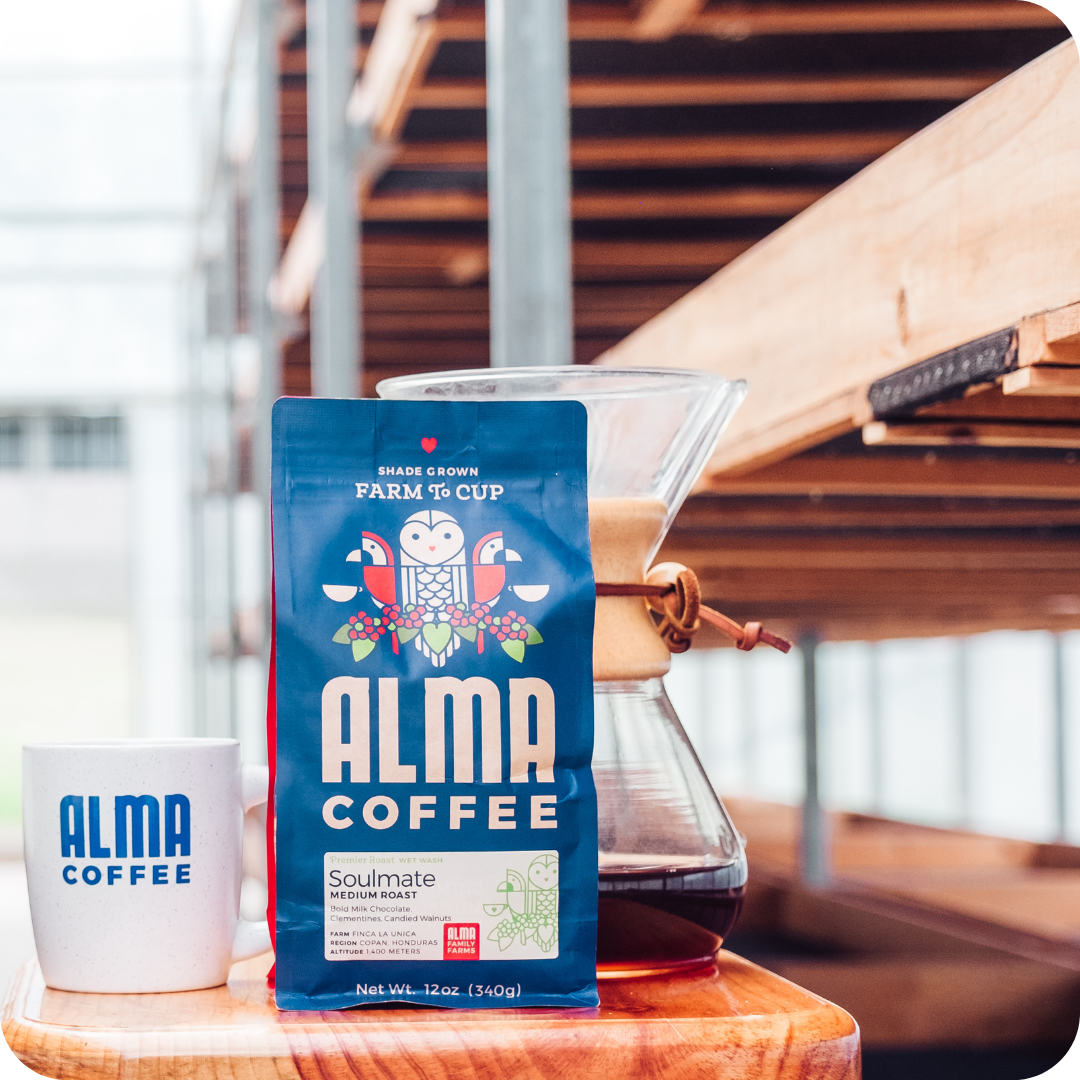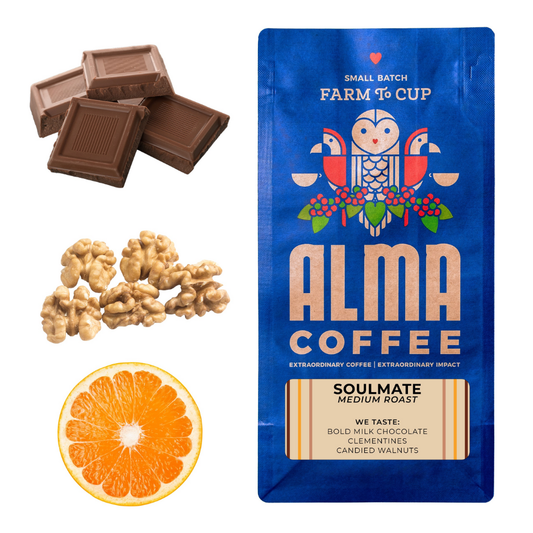
What is Coffee Washing & How Does It Affect Your Cup?
Share
You may have come across this blog post a number of different ways, but we want you to imagine this particular scenario: Let's say you go to your favorite coffee roaster, Alma Coffee in this case, and order a bag of delicious medium roast coffee.
You admire the bag design, break open the airlock seal, and inhale those a-maz-ing coffee scents. But you start to ponder.... How exactly was this coffee made?
Sure, the bag gives really cool information such as the roast profile and farm elevation, but you see something on the label that you don’t fully understand—"washed process coffee."
What is a “washed process” and how exactly does that influence the coffee flavor?
This week’s blog will cover something we’ve hinted at in MANY blog posts before and that’s the process of coffee washing. (Your Morning Coffee is in Danger! Will You Help Save It?, Roasts You Should Know: Soulmate)
More specifically, what does it mean to “wash” coffee, why is washing important to the coffee’s taste, and what do you need to understand about washing process next time you purchase direct trade coffee!
But First, Coffee:
Before we start this blog it’s important for us to reiterate exactly what coffee is in the first place—or, in other words, where coffee is grown and produced before the end consumer enjoys a hot cup of joe.
For starters, coffee isn’t actually a “bean” contrary to its popular nomenclature. The coffee tree, grown in natural contexts such as the lush high altitude setting of our Honduran family farm Finca Terrerito, produces a fruit commonly referred to as a coffee cherry.
This cherry contains several layers—the outer skin, the inner mucilage/fruit, and two seeds (a.k.a. coffee “beans”)—which are processed, dried, roasted, ground, and, by the time it gets to you, brewed into a delicious hot liquid.
Before any of that happens, the coffee cherry seed needs to be removed from its outer skin and inner mucilage layer in order to access the seed for drying & roasting.
However, getting to the seed is easier said than done. To better understand the anatomy of a coffee cherry, we like to use the analogy of picturing the coffee cherry as an avocado, with the inner mucilage layer separating the seed and skin being similar in texture in both fruits.
The process of removing the seed from the inner mucilage layer before it’s dried is called coffee “washing," and it can be accomplished in a variety of different ways.
Washed or "WET" Processing:
In a farm like Finca Terrerito, for instance, coffee is processed within 24 hours of being picked. Farmers will complete multiple passthroughs of the coffee trees before washing, only picking the ripest cherries in order to process a lot of cherries at once while avoiding defects.
This brings us to the first and most popular methodology for separating the coffee cherry skins and mucilage from the inner coffee seeds: washed processing or “wet” washing.
After a long day of picking, coffee pickers proudly bring the coffee cherries which they have collected for the day, weigh their totals, and then empty the cherries into a holding tank to then be passed through flotation equipment—the first part of the washing process
This part of the process and the equipment it takes to accomplish it are called "flotation" because water is used to separate the dense & ripe coffee cherries from the buoyant & unripe cherries as well as any twigs/leaves that may have accidentally been collected during picking.
From there, the coffee cherries are then de-pulped, a process where the skin will be removed from the fruit (usually in a machine such as a sieve) before moving to a fermentation vat.
Fermentation, or the process of allowing the cherries to sit in their own inner mucilage, is the most efficient way to remove any of the additional fruit that could be covering individual coffee seeds before drying, and this is the last stop of washed processing coffee cherries.
Washed processing is preferred by many coffee farmers for several reasons:
1.) Unlike other processes for removing coffee cherry seeds, washed processing significantly reduces the amount of crop lost between picking and drying due to the process being more controllable.
2.) Wet washed coffee is more efficient for farmers because it takes a lot less time to dry once the washing process is finalized and can be dried in bigger batches.
Try our Soulmate Roast if you want to taste what a delicious washed process coffee tastes like after roasting!
NATURAL or "DRY" Processing:
If what we described above is commonly referred to as “wet washed” coffee, let's talk about “natural” or “dry” processed coffee.
As we have been describing, processing coffee cherries is a complicated game of getting to the two coffee cherry seeds on the inside in order to dry them prior to roasting. The wet wash process, used by many farmers around the world, is a tried-and-true methodology that processes the most cherries after harvest as fast as possible.
However, despite taking longer and risking more of the harvest, natural processing is quickly becoming a preferred methodology in the specialty coffee world due to its resulting cup being fruity and floral. Some roasters even prefer dry processing simply due to the significant reduction in water usage!
In natural processing, much like a grape to a raisin, fully intact coffee cherries are dried in the sun until mother nature has sufficiently dried the skin, mucilage, and seed(s)—a process that can take upwards of three months.
A lot of things can go wrong in this process, if you can imagine: heavy rain could ruin the process, mold could take over, etc. At Finca Terrerito, farmers dry our natural processed coffees in raised air beds. This not only better protects the cherries from the elements, but also promotes better air flow from above and below in order to have consistent drying.
With the skin and inner mucilage still partly intact on the seed at the end of this process, however, natural or "dry" process leaves roasters with a coffee bean that imparts unique flavor qualities which can’t be replicated in washed processing.
The result, a fruit-forward and lighter body coffee, can be deliciously different than your typical washed process bean. Try our Natural Process roast and taste the difference for yourself!
HONEY PROCESSING:
Between wet and dry processing, you may be wondering the same thing we are right now—can you combine certain aspects of both processes?
The answer is yes, you can: Honey Process!
In most Honey Processed coffees, including our own Honey Process here at Alma, coffee is treated very similar to a wet wash without the fermentation.
However, despite the alluring name, Honey Process doesn't actually involve or contain that golden goo honeybees are so good at making.
For our own Honey Process at Finca Terrerito, coffee cherries are still sorted and de-pulped like they normally would be to leave the layer of mucilage intact to the seed. Before fermenting the seeds in a vat of water, Honey Processed seeds are then left to dry just like a Natural Process.
Honey Processed coffees are very risky to farmers because the mucilage left on the outside of the coffee bean is sticky and acidic. The beans are constantly mixed to avoid them clumping together where mold and uneven drying can ruin the entire batch.
The result? A faster natural drying process and (we would argue) a sweeter coffee that blends tasting elements of the dry and wet processing.
This process is different for every farm, though. What excites us the most about Honey Process is that, unlike wet and dry processing, it requires a lot of trial and error to get the perfect “goldilocks” flavor profile, and that means that every farm could have their own “honey” process distinctly different from others.
Does your favorite type of roast reflect the washing process it started with? If you’re the type of person that claims to only enjoy light or dark coffees, it might not be the roast itself that you like!
Next time you grab a bag of freshly roasted coffee with Alma, check out the roasting process on the label to gauge how that might have influence flavor. We sell roasts that reflect the full spectrum of the washing process, from Natural Process to Wet Wash.
Drop a comment below and let us know what your favorite washing process is, and be sure to subscribe to the Alma newsletter to get notified when our weekly blog post drops!





